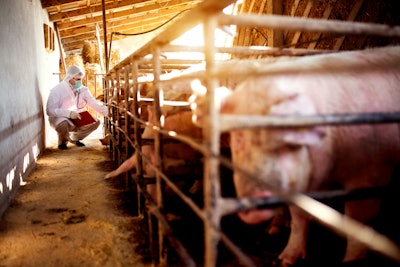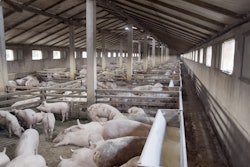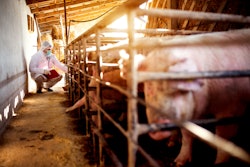
In Europe, many more cases of African swine fever (ASF) have been confirmed over the past week, particularly in Bosnia-Herzegovina and Croatia. Also affected has been a commercial farm in western Russia. Numbers of cases among the wild boar population are also creeping up slowly in several central and eastern European countries.
So far this year, the total number of confirmed ASF outbreaks in domestic pigs in Europe has reached 3,674. This is according to the Animal Disease Information System of the European Commission (EC; as of October 6). The system covers the European Union (EU) member states and most of its immediate neighbors.
Since the previous update (dated September 22), the total has jumped by 526. The number of countries with confirmed outbreaks remains at 16.
For comparison, 12 European states registered a total of 537 outbreaks in this population with the EC in the whole of 2022. Of these, 329 occurred in Romania.
Driving the ongoing rise in confirmed outbreaks in the region are many new cases confirmed in the Balkans states, particularly in Bosnia-Herzegovina, Croatia, Serbia and Romania. Since the EC’s previous update dated September 22, their totals had risen by 276, 91, 111 and 24, respectively.
Registering the highest number of outbreaks in domestic pigs with the EC so far in 2023 is now Bosnia-Herzegovina with a total of 1,135 outbreaks. Following are Croatia (now with 954), Serbia (762) and Romania (686). The next highest national total is 29 in Poland.
Latest to be affected were a small herd in the northwest Polish province of West Pomerania, and one with almost 200 animals in adjacent Greater Poland, according to the chief veterinary office.
ASF hits many backyard herds in the Balkans
Further details and trends in outbreaks are contained in regular official notifications from national veterinary agencies to the World Organisation for Animal Health (WOAH).
During the past week, the authority in Bosnia-Herzegovina has registered 462 outbreaks in domestic pigs with WOAH. Directly affected by these outbreaks were more than 16,600 animals.
These cover a wide time period, with outbreaks starting between the end of July and early October.
All of the reports describe the outbreaks as affecting backyard pigs. While the overwhelming majority of outbreaks have been confirmed in herds of no more than 50 animals, two of the latest herds to be affected had between 550 and 600 pigs, and the largest so far comprised more than 1,376 swine.
Bosnia-Herzegovina’s first cases of ASF were identified in June. Since then, the total reported to WOAH has risen to 1,363, and the number of pigs involved stands at around 55,400.
The main disease “hot spot” is in the country’s northeast, involving premises in all three regions. Of the latest 462 outbreaks to be reported, 291 were in one of three districts in the Republic of Srpska. A further 132 affected premises were located in Brcko, and the remaining 39 in one district of the Federation of Bosnia-Herzegovina.
For one of the Republic of Srpska districts —Trebinje — the ASF virus was first detected at the end of September. These were also the first cases in the far south of Bosnia-Herzegovina.
In recent days, the veterinary authority in Brcko has declared that the ASF situation in the district is now calming down, reported Sarajevo Times.
Also over the past week, the animal health agency of Croatia has reported to WOAH 113 new ASF outbreaks in domestic pigs. These involved just over 3,000 animals, bringing the nation’s totals to 19,028 swine at 915 locations since the end of June.
As in its neighboring state, ASF appears to be mainly confined to backyard herds in Croatia. Outbreaks are reported to WOAH as “clusters,” which have mainly been in the northeastern county of Vukovar-Srijem. Affected so far have been premises in around two-thirds of the districts in this county, including the first cases in two of these districts. Also registering cases in this population have been two districts in the adjacent county of Brod-Posavina.
As part of a long-running battle to control ASF, the Romanian veterinary agency had logged a further 15 outbreaks in domestic pigs with WOAH over the past week. All of these affected backyard herds, and a total of 129 animals.
Outbreaks in wild boar approach 6,500
Up to October 6, the total number of ASF outbreaks across Europe reached 6,450, according to the EC’s System. To date, 20 countries have registered one or more outbreaks through this system so far this year.
For comparison, there were a total of 7,442 outbreaks of ASF in wild boar across 15 European countries covered by the EC System in the whole of 2022.
Since the EC’s previous update dated September 22, 11 countries in this region have reported new ASF cases in this population.
Registering the highest number of outbreaks in this category so far this year is Poland with a total of 2,307. Following are Germany (now with 846 outbreaks in the wild population), Italy (796), Latvia (563), Slovakia (512) and Hungary (357).
In addition to these six nations, also reporting further ASF outbreaks to the EC System since the previous update were Bulgaria, Croatia, Lithuania, Romania and Sweden.
Total confirmed cases among Sweden’s wild boar remains at 49, according to the state veterinary institute SVA.
In order to confirm that ASF is confined to the existing control zone around the town of Fagersta, SVA has announced that hunters can voluntarily submit for testing samples for boar killed in the seven surrounding municipalities.
Another ASF outbreak on a Russian farm
As the disease situation in Russia is not included in the EC’s reports, notifications from the veterinary authority to WOAH offer insights into ASF developments in the country.
Over the past week, an outbreak was confirmed in Krasnodar. Affected this month was a commercial farm with 20,732 pigs, 41 of which died.
Since the first cases in this region of the North Caucasian federal district at the end of August, the number of confirmed ASF outbreaks stands at six. Directly involved have been more than 82,800 domestic swine. Affected premises have been located in different districts of Krasnodar, and appear to be located at least 30 kilometers apart.
According to recent notifications to WOAH, the ASF situation has been declared “resolved” by the Russian authorities in the Saratov region in the Volga federal district, as well as in the Stavropol region of the North Caucasian district. The declarations follow reports of five and one outbreak in these regions, respectively.
View our continuing coverage of the global African swine fever situation.
















